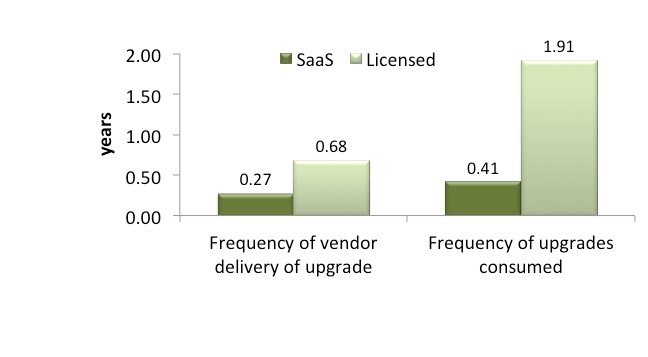How SaaS delivers cost savings

In this article, we look at the benefits of software delivered as a service, commonly referred to as “SaaS”. We’ve previously acknowledged that all SaaS is delivered via the cloud and concluded that not all cloud is SaaS. Indeed, while there are benefits of web-enablement and accessing software via the cloud when it comes to cost savings, SaaS brings significantly more potential.
SaaS-driven cost savings
While the savings come from various sources, the most obvious is the lower start-up cost.
There is no upfront fee for licensing, and implementations are typically a month quicker to the ‘go live’ milestone. Also, removing the cost of hardware and infrastructure purchases, as well as the associated maintenance and obsolescence, makes a massive difference to the cost of SaaS.
The cost and effort of upgrades are also diminished, bringing the total cost of ownership even lower. You also have the option to treat your SaaS investment as an operating expense rather than a capital one.
Despite these factors, some industry influencers (consultants, analysts and industry observers) argue that SaaS is no less expensive, reflecting a “rent versus buy” mentality. But licensing software is very different from purchasing a house. You are not building equity in your software purchase – you’re doing quite the opposite.
The naysayers usually highlight the break-even points in the five– to seven-year range. In other words, after five (or seven) years, you will have paid just as much for your software as if you had licensed and run it on-premise. However, they rarely look at the complete picture or consider the hidden costs. Even if they are right, it still implies that you paid less at start-up.
Also, once you’ve reached the break-even point, the costs associated with a traditional license don’t stop. The costs of maintenance, staff, and obsolescence remain.
Let’s look into each of the different opportunities for cost savings offered by SaaS.
Start-up costs are lower
While some understand how business software is “bought and sold”, many business leaders still don’t quite understand that enterprise applications are neither bought nor sold
In the past, the software you used to run your business was always licensed for use, and that practice continues today for on-premise deployments and many hosted ones. It may be licensed to be used by a company, on a particular computer, or by other criteria such as the number of users. This license fee is a one-time, upfront cost that is typically large enough to be viewed as a capital expense.
After the initial payment, there are ongoing recurring costs for maintenance. A maintenance agreement typically provides both technical support and innovations. Some of those innovations will be included in your maintenance fee; others (such as new modules or extensions) might require additional purchase. Maintenance is typically priced as a percentage of the software license and can be accounted for as an operating expense.
SaaS, on the other hand, carries no upfront outlay. You do not license the software; you subscribe to it. The cost of maintenance and upgrades are included in the subscription fee, and you can treat your purchase as an operating expense right away, which lowers the barriers to entry.
There are no hardware and related costs
Not having to purchase hardware, directly and indirectly, impacts your costs. The direct impact is evident – you don’t need to invest in new servers. Expenses won’t disappear until you’ve replaced every on-premise solution with SaaS. Still, by putting less power and storage strain on your existing hardware, you also defer or even eliminate the need to upgrade.
There are also indirect cost savings in eliminating hardware. Your IT staff will spend less time on maintenance and, as a result, have more time to spend on strategically benefitting the business.
A recent Mint Jutras Enterprise Solution Study found that 31% of companies that had moved to SaaS had reduced the size of their IT staff complement. The remainder – and the majority (69%) –had redeployed people strategically, providing more opportunity for these employees to add value.
Value is seen faster
Mint Jutras measures time to value in two ways.
First, it measures the expected and actual time to achieve the first “go live” milestones. This metric is chosen for two reasons.
One, it is less variable than a full implementation, but you must keep in mind that what you accomplish and how much you achieve in arriving at this first milestone can vary.
Some implementations go “big bang” with all functions going live at once. For example, Avenu Insights & Analytics had just six months to implement new business applications to run the company, which supplies revenue enhancement and administration software and services to more than 3,000 state and local governments in the US.
Leveraging Sage Intacct’s cloud financial management platform, Avenu halved its aged receivables accounts, trimmed the monthly close by 20%, and accelerated $2 million in cash flow, thanks to reducing days sales outstanding.
Others may approach it incrementally. For smaller companies or those being split from a larger corporation (on a tight timeline), it might represent their complete implementation. For multinationals with numerous entities and operating locations, it could represent a single division.
With traditional on-premise solutions, this phase includes site preparation, lead time to deliver hardware, and the physical loading of software. SaaS implementations require none of this, leading to faster implementations or ramp-ups for new divisions or expansion.
The second reason we chose this metric is that this is when you are most likely to see specific, quantifiable results.
This leads us to the second way we measure time to value: Return on Investment (ROI).
In the survey, Mint Jutras defined the timeline for ROI to be the time it took to recoup 100% of the initial cost of ERP through cost savings or added revenue. A full 85% of companies surveyed projected a timeline for ROI, and 82% of those who had projected it achieved it. While the average was 2.52 years, those with SaaS implementations shaved about a quarter (three months) off this and averaged recouping their costs in 2.29 years.
The cost and effort of upgrades is reduced
Reducing the cost and effort of upgrades also results in savings. The top challenge that study participants faced in deriving the maximum value from their solutions was the cost and effort of upgrades, which prevented them from innovating. With SaaS, the solution provider does the heavy lifting.
It’s one thing to deliver innovation more frequently, but quite another to consume it. If we average the delivery frequency across all our respondents, we find upgrades provided approximately every six months. Our participants were asked how often they upgraded and found they consumed those upgrades about once every 13 months. With SaaS deployments, upgrades are consumed far more regularly. (Figure 1)
Figure 1: How frequently are these upgrades “consumed?” Source: Mint Jutras Enterprise Solution Studies







Ask the author a question or share your advice